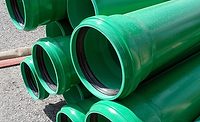Sherwin-Williams Receives SSPC Military Coatings Project Award of Excellence

CLEVELAND – Sherwin-Williams Protective & Marine Coatings, together with the U.S. Navy and Mid-Atlantic Coatings Inc. (MAC), earned the SSPC Military Coatings Project Award of Excellence for their work on the USS George Washington (CVN-73) super carrier. For the second time in five years, Sherwin-Williams stood up to the task of overhauling a thousand-foot U.S. Navy aircraft carrier. Using new coatings and technologies, innovative collaborations and environmentally sustainable solutions, the USS George Washington had a range of critical areas preserved and recoated, from topside to ballast tanks and interior fuel tanks.
The award recognizes exceptional coatings work performed on U.S. military ships, structures or facilities. This year’s honorees will be recognized Feb. 11, 2019, at the SSPC Coatings+ Conference in Orlando, Florida. Sherwin-Williams is a principal supplier of marine and MIL-SPEC coatings to the U.S. Navy and previously won this award in 2014 for a similar project involving the Navy’s USS Ronald Reagan (CVN-76) super carrier.
“From the beginning, we knew this project would require looking beyond the usual horizons – not just in terms of engineering a strategy, but in effectively communicating our innovations and ideas, and collaborating with the right teams,” said Mark Schultz, Government Marine Manager for Sherwin-Williams Protective & Marine Coatings. “Since several aspects of the project were groundbreaking, not only were we challenged to assemble this complex arrangement of features and benefits, we also had to demonstrate how these technologies and teams would come together to deliver on our promise.”
The award-winning coating project was part of the USS George Washington’s multi-year midlife refueling and complex overhaul at the Huntington Ingalls Industries shipyard in Newport News, Virginia. This undertaking included preserving and coating the freeboard, main deck, topside and more than 100 interior tanks, along with prepping and maintaining the underwater hull surface. While the coatings project commenced in August 2017, development began more than two years earlier – reflecting the time and effort required to engineer and demonstrate new technologies, as well as new uses of existing coatings.
“In the past, we’ve typically used a two-coat system on freeboards, but we enhanced efficiency by using Sherwin-Williams Fast Clad® ER, a single-coat solution, on about 70% of the freeboard instead,” Schultz explained. “This was a first, and there was no sacrifice to durability. The product’s four-hour cure time allowed us to accelerate coating schedules, while also eliminating the possibility of missing recoat windows – a problem that can lead to delamination issues.”
The project used Sherwin Williams SeaGuard® 5000HS Epoxy for the remaining 30% of the freeboard, with Sherwin-Williams Polysiloxane XLE-80 HAPS Free Epoxy Siloxane applied as a topcoat on the entire area. The Polysiloxane XLE-80 coating included a newly designed and approved Naval Research Lab low solar absorption (LSA) pigment package. This formulation enhances the paint’s signature “Navy Gray” color stability and reduces the solar temperature load on the vessel.
Within the ship, more than 100 tanks designed to hold ballast, chemicals, fuel, water and waste were also coated with Fast Clad ER, which offers long-term immersion service for up to 15 years. The coating marks another advancement for use on seafaring vessels.
“The benefits of high solids coatings are coming to fruition,” Schultz said. “We started with 98% solids Dura-Plate® tank coatings more than a decade ago, and we’re seeing those tanks hold up very well during inspections with no required rework. We’ll see even more success down the road when they re-inspect tanks featuring Fast Clad ER.”
Teams applied the coatings using plural-component sprayers and – in another innovative move – utilized cartridge technology from V.O. Baker Co. developed for plural-component materials. Cartridges provide precise measurements for dispensing, which help reduce the chance of mixing errors and allow teams to work longer. More than 95% of the touchup and repair work following the initial spray application was completed exclusively with cartridges.
Another new technology played a role in the project’s surface preparation. Sherwin-Williams worked with Greener Blast Technologies and introduced the Naval contractors to vapor blasting, which uses a water-like medium to reduce dust levels during surface prep. This technique was used as the first blast to remove exterior built-up materials, such as biofouling and the outermost coatings before the secondary direct-to-steel blasting. Impressed by the process, the Navy created a new SSPC/NACE specification for vapor blasting.
Vapor blasting was another part of the team’s efforts to find innovative ways to reduce the environmental impacts of the surface preparation work. Traditional sandblasting on an aircraft carrier creates massive amounts of waste and dust requiring containment and significant time consuming cleanup, whereas vapor blasting cuts down on both, while providing a similar blast profile. In addition, the contractor was able to complete the second blasting stage – abrasive blasting – more quickly and with far less debris due to the first round of vapor blasting.
Utilizing a vapor blasting process also produced additional advantages for the project. Working with water-powered pressure washers instead of gas-powered washers decreased fuel emissions, and the abrasive blasting process used recycled steel grit in the tanks. Additionally, slurry from the vapor blasting could be cleaned and recycled, further reducing waste.
“We always aim to take steps that improve sustainability and reduce environmental impact, especially on projects of this scope,” Schultz said. “The results across the board couldn’t have been achieved without the intense cooperation of our dedicated teams and partners, or the support of the Navy when we suggested new solutions for the future.”
The USS George Washington restoration project is an example of Sherwin-Williams’ commitment to improving the coatings selection and application techniques for the U.S. Navy, helping the organization enhance efficiencies and realize lifecycle improvements throughout its operations.
Looking for a reprint of this article?
From high-res PDFs to custom plaques, order your copy today!









